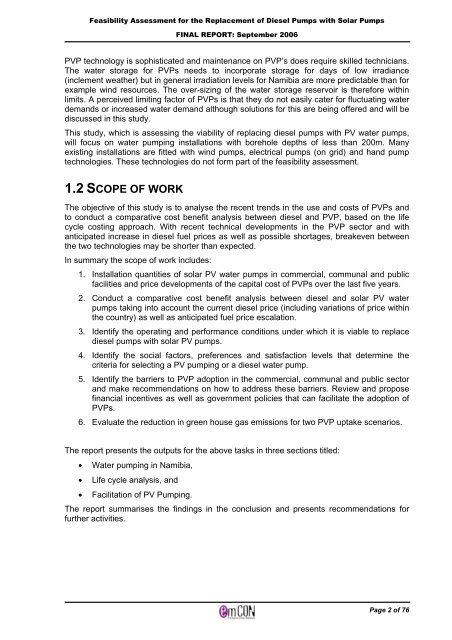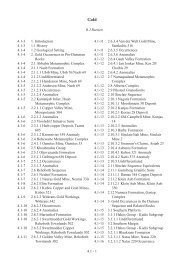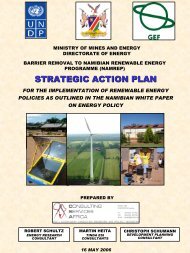Solar PV water pumping study - FINAL REPORT ... - UNDP, Namibia
Solar PV water pumping study - FINAL REPORT ... - UNDP, Namibia
Solar PV water pumping study - FINAL REPORT ... - UNDP, Namibia
You also want an ePaper? Increase the reach of your titles
YUMPU automatically turns print PDFs into web optimized ePapers that Google loves.
Feasibility Assessment for the Replacement of Diesel Pumps with <strong>Solar</strong> Pumps<br />
<strong>FINAL</strong> <strong>REPORT</strong>: September 2006<br />
<strong>PV</strong>P technology is sophisticated and maintenance on <strong>PV</strong>P’s does require skilled technicians.<br />
The <strong>water</strong> storage for <strong>PV</strong>Ps needs to incorporate storage for days of low irradiance<br />
(inclement weather) but in general irradiation levels for <strong>Namibia</strong> are more predictable than for<br />
example wind resources. The over-sizing of the <strong>water</strong> storage reservoir is therefore within<br />
limits. A perceived limiting factor of <strong>PV</strong>Ps is that they do not easily cater for fluctuating <strong>water</strong><br />
demands or increased <strong>water</strong> demand although solutions for this are being offered and will be<br />
discussed in this <strong>study</strong>.<br />
This <strong>study</strong>, which is assessing the viability of replacing diesel pumps with <strong>PV</strong> <strong>water</strong> pumps,<br />
will focus on <strong>water</strong> <strong>pumping</strong> installations with borehole depths of less than 200m. Many<br />
existing installations are fitted with wind pumps, electrical pumps (on grid) and hand pump<br />
technologies. These technologies do not form part of the feasibility assessment.<br />
1.2 SCOPE OF WORK<br />
The objective of this <strong>study</strong> is to analyse the recent trends in the use and costs of <strong>PV</strong>Ps and<br />
to conduct a comparative cost benefit analysis between diesel and <strong>PV</strong>P, based on the life<br />
cycle costing approach. With recent technical developments in the <strong>PV</strong>P sector and with<br />
anticipated increase in diesel fuel prices as well as possible shortages, breakeven between<br />
the two technologies may be shorter than expected.<br />
In summary the scope of work includes:<br />
1. Installation quantities of solar <strong>PV</strong> <strong>water</strong> pumps in commercial, communal and public<br />
facilities and price developments of the capital cost of <strong>PV</strong>Ps over the last five years.<br />
2. Conduct a comparative cost benefit analysis between diesel and solar <strong>PV</strong> <strong>water</strong><br />
pumps taking into account the current diesel price (including variations of price within<br />
the country) as well as anticipated fuel price escalation.<br />
3. Identify the operating and performance conditions under which it is viable to replace<br />
diesel pumps with solar <strong>PV</strong> pumps.<br />
4. Identify the social factors, preferences and satisfaction levels that determine the<br />
criteria for selecting a <strong>PV</strong> <strong>pumping</strong> or a diesel <strong>water</strong> pump.<br />
5. Identify the barriers to <strong>PV</strong>P adoption in the commercial, communal and public sector<br />
and make recommendations on how to address these barriers. Review and propose<br />
financial incentives as well as government policies that can facilitate the adoption of<br />
<strong>PV</strong>Ps.<br />
6. Evaluate the reduction in green house gas emissions for two <strong>PV</strong>P uptake scenarios.<br />
The report presents the outputs for the above tasks in three sections titled:<br />
• Water <strong>pumping</strong> in <strong>Namibia</strong>,<br />
• Life cycle analysis, and<br />
• Facilitation of <strong>PV</strong> Pumping.<br />
The report summarises the findings in the conclusion and presents recommendations for<br />
further activities.<br />
Page 2 of 76




